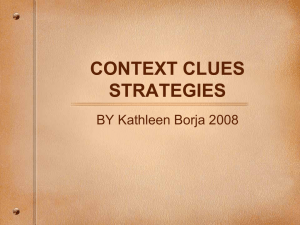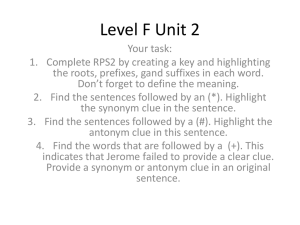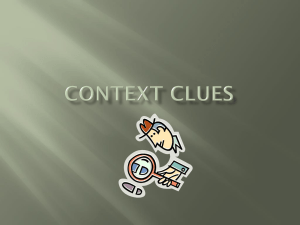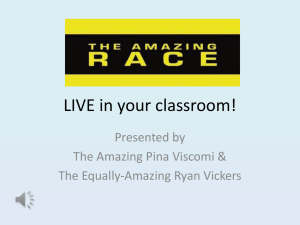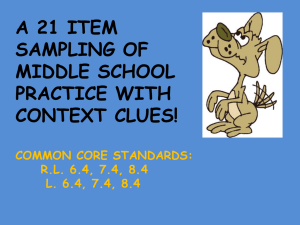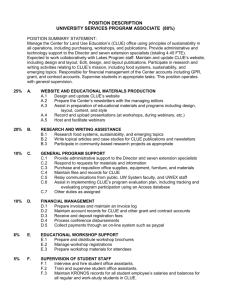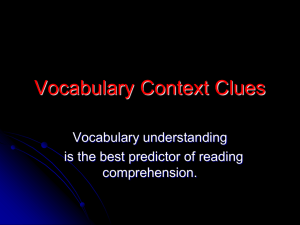Foreman and Ireland Authentic Activities
advertisement
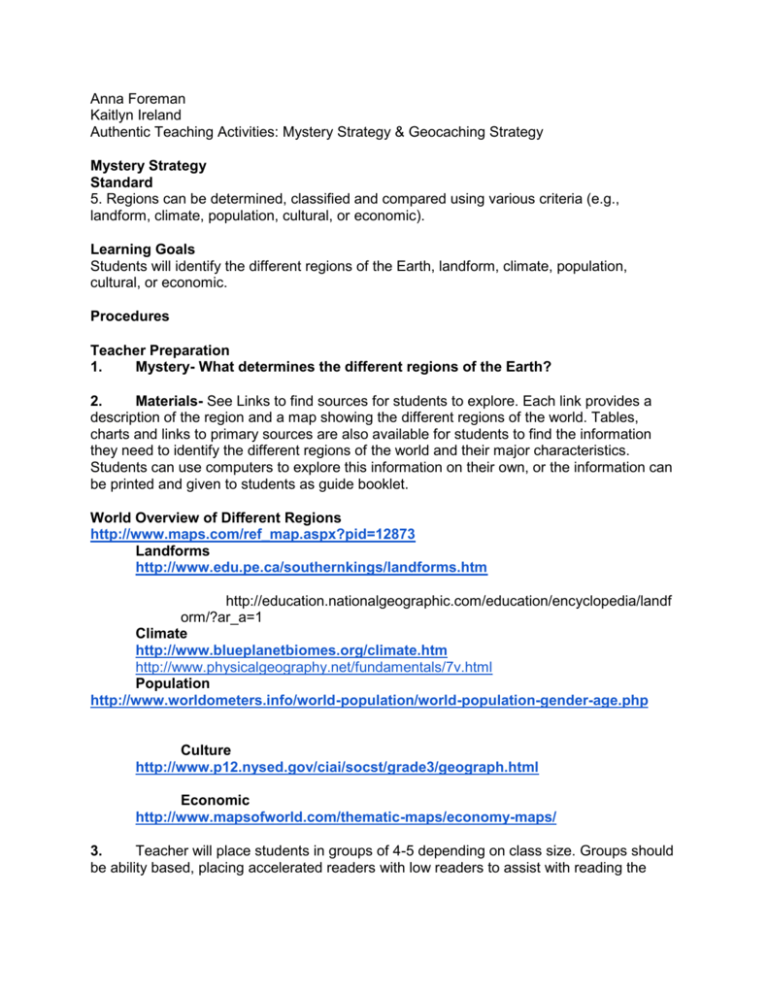
Anna Foreman Kaitlyn Ireland Authentic Teaching Activities: Mystery Strategy & Geocaching Strategy Mystery Strategy Standard 5. Regions can be determined, classified and compared using various criteria (e.g., landform, climate, population, cultural, or economic). Learning Goals Students will identify the different regions of the Earth, landform, climate, population, cultural, or economic. Procedures Teacher Preparation 1. Mystery- What determines the different regions of the Earth? 2. Materials- See Links to find sources for students to explore. Each link provides a description of the region and a map showing the different regions of the world. Tables, charts and links to primary sources are also available for students to find the information they need to identify the different regions of the world and their major characteristics. Students can use computers to explore this information on their own, or the information can be printed and given to students as guide booklet. World Overview of Different Regions http://www.maps.com/ref_map.aspx?pid=12873 Landforms http://www.edu.pe.ca/southernkings/landforms.htm http://education.nationalgeographic.com/education/encyclopedia/landf orm/?ar_a=1 Climate http://www.blueplanetbiomes.org/climate.htm http://www.physicalgeography.net/fundamentals/7v.html Population http://www.worldometers.info/world-population/world-population-gender-age.php Culture http://www.p12.nysed.gov/ciai/socst/grade3/geograph.html Economic http://www.mapsofworld.com/thematic-maps/economy-maps/ 3. Teacher will place students in groups of 4-5 depending on class size. Groups should be ability based, placing accelerated readers with low readers to assist with reading the information provided. Groups should work collaboratively with each other and all provide an equal amount of help while solving the mystery. 4. Teacher will provide mystery clues (see worksheet at end). There are 10 clues on landforms and students will use the resources they have been provided with to match each clue with the proper definition. Their goal is to identify the major regions in the world. This activity is meant to be an introductory activity to all of the different regions and what makes them up around the world. Student Activities 1. In the student groups, students will be given the clues cut apart in an envelope. Using the resources provided, they will match the term with the correct definition. Throughout the activity they will discuss different characteristics of the regions and take notes based on their findings. Their notes only need to include the major characteristics of each region. 2. Students will work on forming their hypothesis about what they have found. Students who have questions or are struggling will be given guiding questions asking about similarities and differences. 3. We will have a whole group discussion based on the students’ hypothesis. Each hypothesis and conclusion will be written on the board and we will prove whether or not these are correct or not. The goal of this activity is to come to a conclusion that there are many different aspects and characteristics of the different regions of the world. 4. Students will write a reflection stating what they learned from the activity and how they came to that conclusion. Some guiding questions students can be asked are: What helped you form your hypothesis? What helped you find the conclusion? From the hypothesis we discussed as a class, which one do you think is best? Mystery Clues Teachers will cut these apart and put them in envelopes for students to match the term with the correct definition. They will use the resources provided for them. ‘ Landforms Natural, physical features of the Earth, valleys, plateaus, hill, mountains, Climate Long term trend in weather element, average temperature, average rainfall Population Data about people who live in a certain area, population density and birth rates Culture Learned Behavior of people including belief systems and people Economic Ways a society determines ownership, including natural resources, agricultural products and levels of income Landform I am formed by erosion Climate I am determined by temperature and precipitation Population I am determined by how many people live in a certain area. Culture I make up a certain area of people who have the same beliefs and people Economic I am determined by the amount of income a specific area makes. Geocaching Standard 4. Latitude and longitude can be used to identify absolute location. 5. Regions can be determined, classified and compared using various criteria (e.g., landform, climate, population, cultural, or economic). 16. When selecting items to buy, individuals can compare the price and quality of available goods and services. Learning Goals Students will be sent on a scavenger hunt to find the necessary items to make and sell lemonade. Students will use what they learned from the Mystery Strategy Lesson to answer riddles, and will solve math equations to determine where to find the items they need. Procedures: Teacher Preparation In order to prepare for this activity, a set of locations within the school must be predetermined. Each location is designated on the maps that follow. After completing the activity, students will return to the classroom where they can enjoy “their lemonade”. In this activity, students will be on a quest to collect items they need to make lemonade. Each clue contains two sets of coordinates, and students will have to locate these places on their world map. Based upon the given clues, students must use the clues to determine which is the correct location, and compare the location on their world map and the corresponding letter on their clue to the letters and classroom numbers on the school map to find where to go within the school. Each location will either contain a stop sign with a note that states “STOP! You have made a wrong turn. Go back and try again!”, or a sign that states “Congratulations! You chose the correct coordinates!” with a clue as to where they need to go next. These clues consist of riddles and math problems. To prepare students for the activity, we will complete a review of the mystery strategies activity. Students will need to know how to read coordinates and use them to find locations on a map. Students will also need to be introduced to the school map that corresponds with the coordinates on their world map and clues.. Students may also need to know terms such as climate, land form, and population. Climate- the usual weather conditions in a particular place or region Land form- a natural feature (such as a mountain or valley) of the Earth's surface Population- the number of people who live in a place Longitude- distance measured in degrees east or west from an imaginary line (called the prime meridian) that goes from the North Pole to the South Pole Latitude- distance north or south of the equator measured in degrees up to 90 degrees Global Coordinates - A geographic coordinate system is a coordinate system that enables every location on the Earth to be specified by a set of degrees and cardinal directions using longitude and latitude Student Job Descriptions: Students will be traveling in small groups of 4, and students will have rotating jobs: Navigator- Uses the world map and school map to lead the group to their destination after the riddle/problem is solved. They are in charge of carrying the maps and the clues they have collected. Cartographer- Upon arrival at their destination, this student will read the next clue/problem to the group for them to solve to continue their quest. They are also in charge of solving the clue on the paper (if applicable) and circling the location they believe to be correct. Journalist- This student documents their journey using a recording device. They turn their recorder on at each location so their group can orally report what they found, as well as the process of how they solved their clue to find the next location. (Students must also make note if they “make a wrong turn” and choose an incorrect location). Photographer- This student takes a picture of the group as they travel to each location to document their journey. Students must photograph each location they visit (even if they choose an incorrect location), and collect the item that is left at each location (lemon, sugar packets, mini bottled water (water), empty bottle). Student Clues For Scavenger Hunt NOTE: Portions highlighted in clues are NOT provided for students. They are the portion included in the answer key. CLUE 1: LEMONS! Everyone knows the key ingredient to making lemonade is...LEMONS! Your job is to find where lemons grow by solving the following riddle (Hint: Find the coordinates on your map FIRST, then use the clues to determine where to go!) I am one of the 50 states, and I must say, I am pretty great! The weather can get pretty hot, thats why the beach is the best spot! Lemons love to grow here you see, So come get some lemons and visit the sea! Location Choices: A. 28°N 81°W B. 64°N 151°W Fun Fact: You are in Florida! Florida has the perfect climate for growing lemons! CLUE 2: SUGAR! To sweeten your lemonade, you need to add SUGAR! To find sugar, you need to find the area whose population is 195,000,000. Solve the following math problems to determine where you can find sugar! C. 1,925,000 x 80 154,000,000 Location Choices: C. 46°N 2°E D. 2,600,000 x 75 195,000,000 D. 10°S 53°W Fun Fact: You are in Brazil! Brazil is one of the largest sugar cane producers in the world! CLUE 3: WATER! To make the lemonade, you still need water! Use the clues to determine where to go next! (Hint: Find the coordinates on your map FIRST, then use the clues to determine where to go! Also, use what you know about landforms to help!) Clue 1: Many penguins live at this location. Clue 2: It is always very cold here. Clue 3: This location has many glaciers and icebergs. Location Choices: E. 74°S 48°E F. 21°N 102°W Fun Fact: You are in Antarctica! Antarctica has an abundance of snow and ice which can be collected and melted down to create water! CLUE 4: BOTTLES! Now that you have collected all the necessary ingredients, you need bottles to store the lemonade in! Solve the following riddle to determine where to go next! (Hint: Find the coordinates on your map FIRST, then use the clues to determine where to go!) This location can be very warm, But being in the ocean can be bad during a storm. You may see Kangaroos while you’re here, and you can surf over at the pier. Let us go and travel down under, what else will you find? I wonder! Location Choices: G. 26°N 29°E H. 25°N 133°E Fun Fact: You are in Australia! Australia has a large manufacturing plant that can produce the bottles you need for your lemonade! CLUE 5: GO BUY YOUR LEMONADE AT THE STORE! In order to buy your lemonade, you want to find the best price! Solve the two math problems to determine the price of lemonade at each of the two locations. The prices given are for a pack of lemonade, and you only need one bottle! Find the price for one bottle of lemonade. Go to where the lemonade is the cheapest! I. 6 bottles cost $27.00 J. 4 bottles cost $24.00 total 27 divided by 6= $4.50/bottle 24 divided by 4= $6.00/bottle Location Choices: I. 41°N 83°W J. 20°S 46°E ***Students who correctly complete the scavenger hunt will travel the following pattern: Begin at Room 319 → Room 605 → Room 401 → Room 209 → Room 418 → Room 319 CLUE 1: A. 28°N 81°W B. 64°N 151°W CLUE 2: C. 46°N 2°E D. 10°S 53°W CLUE 3: E. 74°S 48°E F. 21°N 102°W CLUE 4: G. 26°N 29°E H. 25°N 133°E CLUE 5: I. 41°N 83°W J. 20°S 46°E http://www.portageps.org/schools/middle/wms/information/WestMiddleMap.jpg LOCATIONS: CLUE 1: A. 28°N 81°W (ROOM 605) B. 64°N 151°W (ROOM 613) CLUE 2: C. 46°N 2°E (ROOM 110) D. 10°S 53°W (ROOM 401) CLUE 3 E. 74°S 48°E (ROOM 209) F. 21°N 102°W (ROOM 705) CLUE 4: G. 26°N 29°E (ROOM 413) H. 25°N 133°E (ROOM 418) CLUE 5: I. 41°N 83°W J. 20°S 46°E (ROOM 406) (ROOM 319)
